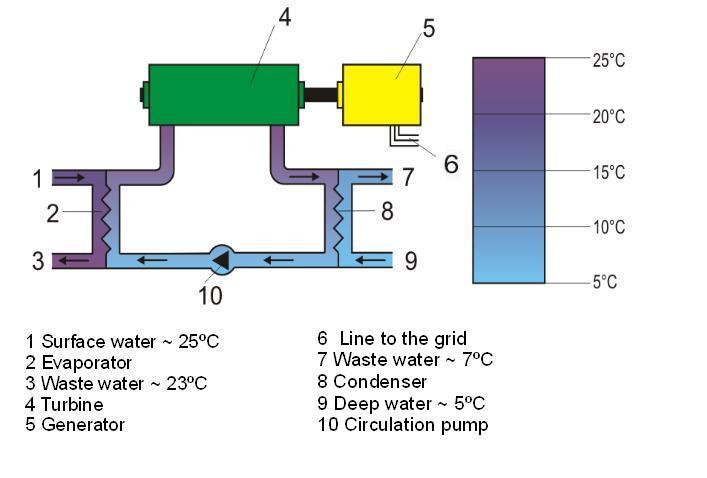Ocean thermal energy conversion
Ocean thermal energy conversion or simply OTEC is the process of using the ocean itself as a solar collector. This technology is still highly theoretical, and utilizes the slight temperature gradient between the warm surface of the ocean and the cooler water deeper down. This technology operates in a similar way that solar ponds do but on a much larger scale. Although there is a temperature gradient, the overall temperature difference with depth is fairly small. In waters deeper than 1000 meters the temperature change might only amount to 20°C.[1] Because of this very slight temperature gradient the efficiency of these systems are likely to be extremely low - only about 2%.[2]
Although the technology is still fairly theoretical there have been more large scale experiments recently. These large scale experiments have taken place in the Pacific ocean and have had moderate success. Even though the tests have been partially successful, the engineering required to make these technologies viable is still a ways off in the future. The amount of water that needs to be pumped is a major issue, as a single OTEC station producing 10 MW of electricity would need to pump around 500 cubic meters of water per second.[1]
How it Works
OTEC power plants could be built in several different ways, either as platforms similar to offshore oil rigs or as free floating structures. OTEC plants could also be constructed as large ships that would move throughout tropical oceans to find areas with the largest temperature differences. Practically speaking, it makes the most sense to put OTEC facilities in tropical areas as these regions of the ocean see the largest temperature differences.[2]

OTEC power plants operate like any other thermal power plant, however they require the use of an organic Rankine cycle. In these plants, warm surface sea water heats up some fluid with a low boiling point. The fluid needs a low boiling point because the surface water itself isn't very warm, so generally ammonia is used (which has a boiling point of -33 °C at atmospheric pressure). The warm water heats this fluid, turning it into a gas that drives a turbine to generate electricity. This vapour then comes into contact with a cold reservoir, chilled with cold water from below the ocean surface. This condenses the vapour and the process begins again.[1]
Environmental Impacts
The primary concern with OTEC facilities is the potential harm to marine life that could occur as a result of the mixing of warm and cool ocean waters. This mixing changes the temperature gradient of the ocean in a specific area, disrupting the ecosystem. For example, nutrients that are brought to the surface with the cold deep water could increase the number of fish or lead to algae blooms.[2] If these facilities are large scale, the average ocean surface temperature could even be affected and this would lead to changes in the weather, climate, and ocean circulation.[2]
References
- ↑ 1.0 1.1 1.2 G. Boyle. Renewable Energy: Power for a Sustainable Future, 2nd ed. Oxford, UK: Oxford University Press, 2004.
- ↑ 2.0 2.1 2.2 2.3 R. Wolfson. Energy, Environment and Climate, 2nd ed. New York, U.S.A.: Norton, 2012
- ↑ Wikimedia Commons. (August 13, 2015). OTEC Closed [Online]. Available: https://upload.wikimedia.org/wikipedia/commons/b/bd/Otec_Closed_Diagram_in_English.JPG

